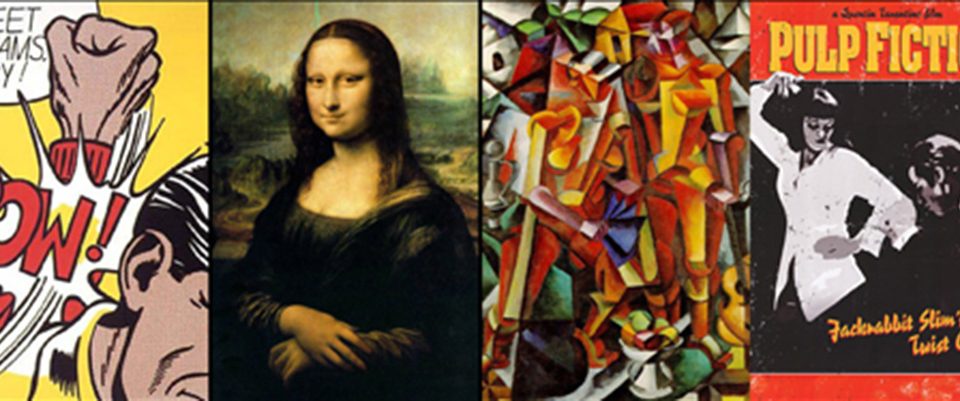
The cover got me. It’s got the Mona Lisa and Pulp Fiction. Plus some Kandinsky-looking abstract and a Lichtenstein pop-art comic-book painting. And this is a Christian book? This has to be cool, right? I have to admit that’s what first got my attention. Things I’m really into: fine art and movie-junkie movies. And it’s about saving Leonardo. What’s wrong with Leo? He was a talented guy. So I picked this up and decided to give it a read.
Now, it took me the better part of a year to read Saving Leonardo: A Call to Resist the Secular Assault on Mind, Morals, and Meaning. The first part is a bit slow, but certain parts really stood out for me and got my attention. Like most good books, once I hit a certain point, I couldn’t put it down. Nancy Pearcey did a good job with this.
It’s 336 pages, so it’s not a quick read. But it’s aimed at the “student of culture” and Pearcey’s goal is is to expose “secularism’s destructive and dehumanizing forces.” What this means is that what you see and hear in the arts and the media is not necessarily innocent (the buzzword to use is “value free”) but deliberately set against Judeo/Christian thought.
The Fact-Value Split
It starts off with a look at the fact-value split in today’s society and how that has affected many Christians. This refers to the idea that facts are essentially empirical data, but values are personal opinions and thus inferior to facts. This leads to the whole mentality that says “you can have your opinion, I’ll have mine, but that doesn’t make either one true”:“Values are not considered matters of truth but only personal perspectives and preferences.”The problem is that many Christians slide into this same line of thinking: “If someone wants to do something immoral, that’s their prerogative. In fact, I’ll even support them because it’s bigoted to do otherwise.”
This is where secular thought becomes destructive, because it slowly unravels one’s conviction in the Christian faith, which is based on certain absolutes.
The Threat of Global Secularism
The first section, The Threat of Global Secularism, is about the need for tools for detecting the underlying philosophies present in culture today, in movies, the arts, media, schools, even Saturday morning cartoons. Pearcey goes to great lengths to caution against the “fortress mentality” that is so prevalent in Christianity, which ends up isolating us from the world instead of helping us become familiar with the very world we are trying to bring to Christ.Two Paths to Secularism
The second section, Two Paths to Secularism explores the root of the fact-value split and the two main ways our society has taken to arrive where we are today. So how did we get here?This split occurred when The Enlightenment, or Analytic Tradition, began. Enlightenment is based in fact, scientific method, and above all, reason. The other route is the Romantic path, or Continental Tradition. It is rooted in story, myth, and imagination. Eventually, either stream becomes reductionistic and destructive.
The final two chapters are the most practical. The most entertaining is Chapter 9, Morality at the Movies. It reveals the agendas behind some popular films. Many are most definitely not “value free,” no matter how much they pretend to be.
The epilogue gives a great example of how art can reach the world for Christ by demonstrating the effects of Bach’s music on Japanese fans today, and how his music, more than 200 years after his death, can lead people to Christ.
What I think
It’s a bit academic, but it isn’t dry. It does require some foundation in art history. It might help to read Zen and the Art of Motorcycle Maintenance first, which is all about the Classic-Romantic split (Pirsig’s term for the same split).There were times reading Saving Leonardo where I felt it would have been a good textbook for the “Christian in the Visual Arts” class I took my senior year at Harding University, but the tone is engaging and well-informed. Reading it, I felt like I was having coffee with a smart professor who is truly interested in helping me understand the way our culture operates.
It’s very sympathetic to the arts and artists. Pearcey herself is a trained violinist coming from a family of musicians, and she studied under Francis Shaeffer, so she has a firm grasp of the art world and today’s socio-political landscape.
The fact that it is filled with full-color images of artworks relevant to the topic at hand keeps visual types engaged.
It’s a must-read for anyone wanting to make a difference in the world with their art, because understanding the culture your art “lives” in is important to keeping it relevant.



[…] But if you want an updated version that doesn’t require a glossary and has a nifty appendix called “Morality at the Movies,” check out Nancy Pearcy’s Saving Leonardo. Pearcy was a student of Shaeffer’s, and she picks up where Shaeffer left off, making it more visual and relevant for today. I reviewed Saving Leonardo last year. […]
[…] The clash between the Enlightenment and the Romantic movements is an exemplary illustration of the Classic-Romantic split that Zen and the Art of Motorcycle Maintenance talks about. This movement grew into the Romantic […]